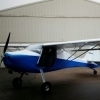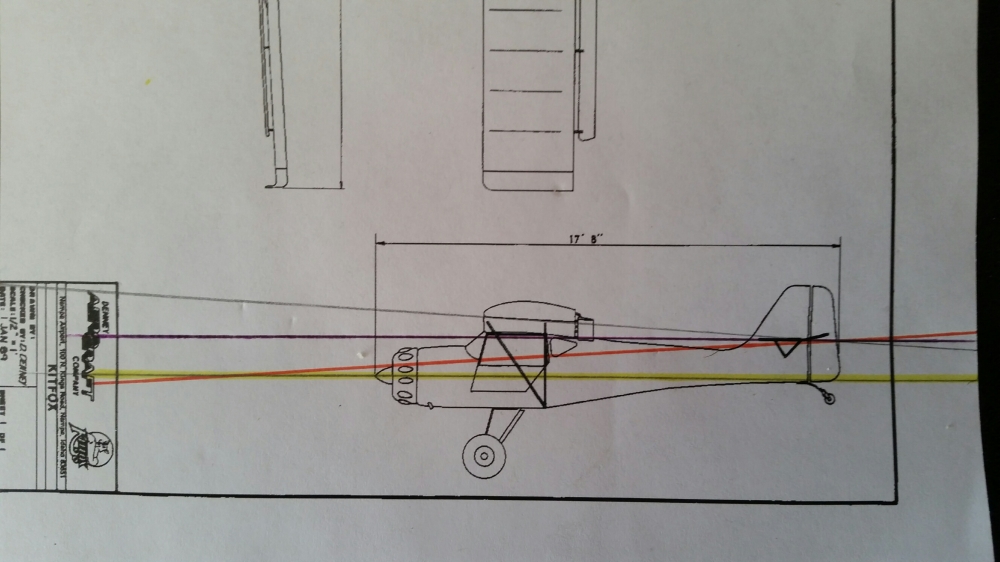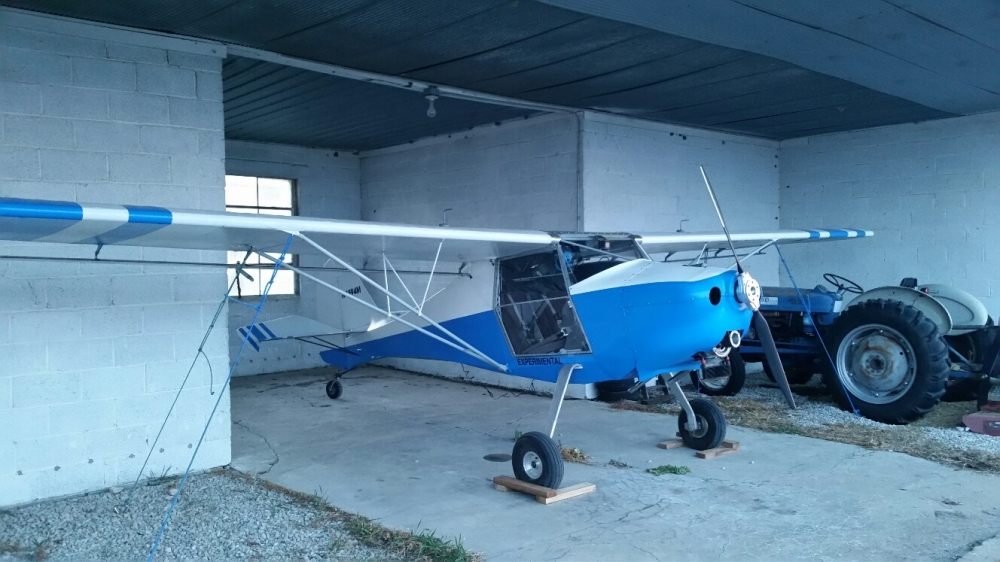-
Content count
34 -
Joined
-
Last visited
Posts posted by ne14Yah
-
-
I know this is an old thread, but wondering if there was a consensus on whether or not it was normal for the oil tank level to rise during operation and then settle when cold? My 582 99 BH mounted on an Avid Flyer Mod B rises about 5/16" during operation and then settles back to normal full cold level.
-
Jim, what is the spacing on the round stock that supports the mains on the trailer?
-
Jim, what was your process for the tank sealing?
-
So, finally have the results of the prop pulls which we did today:
- 68" Warp Drive 2 blade @ 13 degrees = 260 lbs @ 4600 on the tach / 2396 at the prop
- 78" x 35" 2 blade CATTO = 325 lbs @ 4300 on the tach / 2240 at the prop
The original set up and how I received it was 10 degrees on the warp drive. Probably around 200 lbs of thrust achieved. It's amazing it left the ground! Anyway, it was confirmed that it was under propped. Just discovered I have a leak in the right wing FG fuel tank. Anyone have any ideas on the best approach to sealing it? it is traveling out to and dripping from the rear spar attach bolt. I am really hoping I won't have to open it up.
-
I measured the washout from the underside of the leading edge to the trailing edge. Would be greater than from spar to spar, so probably was set at 2". The static rpm is 4600 with 13 degrees pitch - about 2400 then at the prop on the ground. With the airframe being stretched 16" over a standard Avid MK4, would the CG be slightly different or would you expect it to be the same?
-
- W&B shows datum at leading edge of wing. Forward CG is 11.185 aft. Aft CG is 16.5. With 200 lb pilot and 90 lbs of fuel, the CG is 14.28 Dry weight is 744. Gross is 1400 design/1320 legal.
- Washout is 2 3/4" on right wing 2 3/8" on left wing. Left wing can be adjusted. Right is fixed. Leading and trailing edges are straight.
- Prop is 68 1/2" diameter, right hand turning in right direction. Blades facing proper direction.
- 1.92:1 belt reduction drive
* With horizontal stabilizer held up at level, the left wing experiences negative incidence (relative wind hitting top surface).
-
Anyone have HH STOL wings they want to sell? Or perhaps some insight as to how someone can assemble the parts needed to build a set? I had originally planned on doing so anyway, but now it looks like a priority.
-
Finally able to get briefed from my IA friend who hopped it down the runway. He said it "just doesn't want to fly." He barely was able to get it a couple of feet in ground effect after "prying it off of the runway." He suspects it's a combination of not enough prop, low lift wing design and not enough wing incidence (Not sure of the thrust line issue - will look into it more when he's out next). I sat right seat on his 3rd run to monitor engine gauges and on that run, he said we were at 65/70 mph and it would not fly. He also commented that he did not feel it was safe to fly it around the patch. I wish I had that information prior to my attempt the other day. We will be discussing needed changes hopefully this week when he is out to test another prop and check pulls. Bottom line, I am not going to be able to 'just fly it and have fun.'
-
Jim, on page 1 I laid out that for the most part the HS, wing root cord and thrust line are all parallel, but the thrust line is about .5 degree tilted back from being parallel. You can see how severe it is tilted back in the close-up pic i posted. I do not have any info regarding a "red line" other than a piece of red tape on the tach @ 5500. The wash-out is about 3.5 degrees, what ever that works out in inches. I don't have the CG info handy, but empty it is more forward in it's acceptable range - so more nose heavy. I am hoping to measure static thrust soon. Waiting on my IA friend to assist when he has some time.
-
1Avidflyer, do you have any washout in your wing? If so, how much?
-
I wasn't focusing on static rpm at the time I was playing with the jetting, so no static run before. All it wanted to do was load up when reducing power. It was obviously running too rich. I spoke with a Harley guy who confirmed it and electronic timing was not advanced enough. 1Avidflyer, my wing is not a flat bottom chord like yours. It's more semi-symetrical. My instinct is telling me that the relative wind is not hitting the wing correctly. It also has a lot of wash-out, so at the wing tips, the relative wind is on top of the wing.
-
As suspected, looks like the thrust line is an issue. Spent the better part of 2 days dialing in the jetting. Purring nicely now. Straightened out a miss-rigged tail wheel to the rudder (canted off center relative to the rudder). Prop pitch had been 10 degrees on one blade and 9 degrees on the other. As mentioned, didn't seem to be producing enough airspeed, so increased to 13 degrees. Producing 4600 rpm static, so in the ball park I suspect. High speed taxing seems to feel like we are getting somewhere. So, today was the day I was going to take her up. Thankfully it was a nice cool morning with light wind down the runway. Expected to get light around 40 or so, but nothing. Increased to above 50 and knew something wasn't right. Still nothing. Made the mistake of forcing off the runway and the rodeo began. Wild porpoising with it wanting to stick to the runway like a magnet. Looks like we will be modifying the engine mount. Should have trusted my instincts. Thankfully, no harm done, but could have easily been a real bad day.
-
"P" factor would be the left/ right line. But its your plane, do as you think best. As for the picture, Ray Charles could see the difference, but you could shim the mount, engine, or redo the cowling. But if you don't know how it flys now, you wouldn't know the results of whatever you do. Positive or negative or no change. A lot of planes have a 1.5 deg down mount, a lot don't so you could be worrying about something that doesn't exist. My final comment on the subject!
Allen, John Larson is an engineer and the designer of the Avid Mark IV/Airdale and others. He advised me that P factor effects both the right/left and up/down torque tendencies. Just reporting from what he said. I greatly appreciate everyone's wisdom and advice!
-
Correct the engine issues and CG check and go fly the dang thing! If there were no issues or surprises with the crow hops, there is no reason to re-engineer it.
Allen, did you take a look at the picture that shows the prop and the cowl opening? Did you notice that they are not parallel showing my engine to be canted up? John Larson told me that any any engine should have a 1.5 degree down thrust line against the center line to counter P factor. I want to make sure it is inherently safe to fly and the geometry is according to design.
-
My mechanic said, "It is underpropped" after he flew it - length is the problem here. No reported problem with over revving. The CG is good.
-
Would love to have Jerry Mattison's contact info. John provided me with his write-up of the history of the Avid and it's lineage. Was quite an education! Sadly, I have not been able to obtain the answers to my questions regarding it's design geometry and specs. I only have a partial construction drawings and manual and need to find a complete set - hoping I can find the answers within.
So, my mechanic friend did crow hop the Airdale down our runway 3 times and reported that there were no surprises and everything felt as he would expect. There was an issue with the engine bogging when backing off the RPM's slowly, but not rapidly. Need to iron that out. As I mentioned, it is way under- propped, not developing airspeed quick enough.
-
Well, did it again. I edited my last post and those 2 pics automatically loaded themselves. How can I remove those pics from the above post and not end up removing them from the original post where I uploaded them?
-
John Larson chimed in this morning with an email response. He advised the the engine thrust line should be 1.5 degrees down from the center line of the airframe. All other lines should be parallel. So, may need to modify the engine mount. According to what he said, mine would not be a "Back Country" with my airfoil, so looks like it would be the "Cross Country". Now I just need to figure out where is the airframe center line! Anyone have an idea where it would be?
-
Hey, thanks for doing that, 1avidflyer! Actually, I did that with a digital angle finder yesterday and found that, yes, the prop disc was almost perpendicular to the line passing through the leading and trailing spars and the horizontal stabilizer. All within .3 degrees of each other. I trailered it out to KBUM today and hopped down the runway 3 times with an A&P friend of mine. It is severely under-propped with it's 2 blade Warp Drive @ 10 degrees. We are going to try a Catto prop a buddy of his has next time he is able to get my way. Also, need to figure out why it's bogging down when power is reduced at slow rate. Seems alright if you pull power faster. Might be too rich in the midrange? I will get some pics of the wing end rib tomorrow and post.
-
Well, I made a mistake. The original builder is not dead. I spoke with him this morning, but he couldn't elaborate about the lines, only stating that the guy he bought the HD from (Brett - Hog Air, now out of business) fabricated and installed the engine on his air frame. He couldn't remember who established the horizontal stabilizer, but a closer look at the pics indicate that it was installed the way I have it at the time the builder had it. The builder also provided the email address he had for the original designer, John Larson, so shot off an email to him. Hopefully it's still good!
A picture I overlooked shows the words "Speed Wing" hand written on the wing roots, so looks like that mystery may be solved. My wings do not have a flat bottom.
-
I apologize for the reposting of the pics. Not sure why, but they seemed to be added when I made corrections. If I try to delete them, they disappear at their original posting.
-
My airfoil is definitely not your average run of the mill KF1,2,3,4 or Avid airfoil. From what I have gathered, the Riblett 30-612 airfoil was used on the KF 5, 6 and 7 series? I don't believe my airfoil is exactly like the 30-612, but I haven't seen a drawing yet that would show a comparison. How would a similar airfoil mix into the geometry questions I have posed? Would a similar airfoil explain why the lines are not traditional? Is there another forum or thread that anyone could recommend? I will post a picture of the airfoild I have tomorrow, if that would help. Thanks!
-
-
I haven't flown it yet. The orange string in the pics is the horizontal stabilizer extended. You can see a horizontal black marker line at the firewall where it hits the firewall. On the KF4, it shows the horizontal stabilizer extending through almost the top of the door (about eye level) in KF's 3 view drawing, so there is quite a difference between this Avid Airdale and the KF4. I would imagine that the plane of the wing chord, thrust line and horizontal stabilizer line would be critical in stability.
The yellow highlighted line is the KF4 thrust line. The orange line is my horizontal stabilizer line extended, roughly and would represent a thrust line 1" below that. The purple line is an extension of the KF4 horizontal stabilizer line extended roughly according to the drawing. The pencil line represents the wing chord and angle of incidence.




Matco 8 inch wide tailwheel
in Avid and Kitfox parts Suppliers
Posted
Which Matco tail wheel assembly can this be used on?